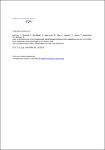Lack of evidence for pre-symptomatic transmission of pandemic influenza virus A(H1N1) 2009 in an outbreak among teenagers; Germany, 2009
Hermes, Julia
Bernard, Helen
Buchholz, Udo
Spackova, Michaela
Löw, Johann
Loytved, Gunther
Süß, Thorsten
Hautmann, Wolfgang
Werber, Dirk
Background: Observations on the role of pre-symptomatic transmission in the spread of influenza virus are scanty. In June 2009, an outbreak of pandemic A(H1N1) 2009 infection occurred at a teenager’s party in Germany. The objective of this study was to identify risk factors for pandemic A(H1N1) 2009 infection. Methods: We performed a retrospective cohort study among party guests. A case was defined as pandemic A(H1N1) 2009 infection confirmed by rRT-PCR who developed influenza-like illness between 1 and 5 June 2009. Contact patterns among party guests were evaluated. Results: In eight (36%) of 27 party guests, the outcome was ascertained. A travel returnee from a country with endemic pandemic A(H1N1) 2009 who fell ill toward the end of the party was identified as the source case. Party guests with pandemic A(H1N1) 2009 infection had talked significantly longer to the source case than non-infected persons (P-value: 0·001). Importantly, none (0/9) of those who had left the party prior to the source case’s symptom onset became infected compared to 7 (41%) of 17 who stayed overnight (P = 0·06), and these persons all had transmission-prone contacts to the source case. Conclusions: In this outbreak with one index case, there was no evidence to support pre-symptomatic transmission of pandemic A(H1N1) 2009. Further evidence is required, ideally from larger studies with multiple index cases, to more accurately characterize the potential for pre-symptomatic transmission of influenza virus.
Dateien zu dieser Publikation
Keine Lizenzangabe

